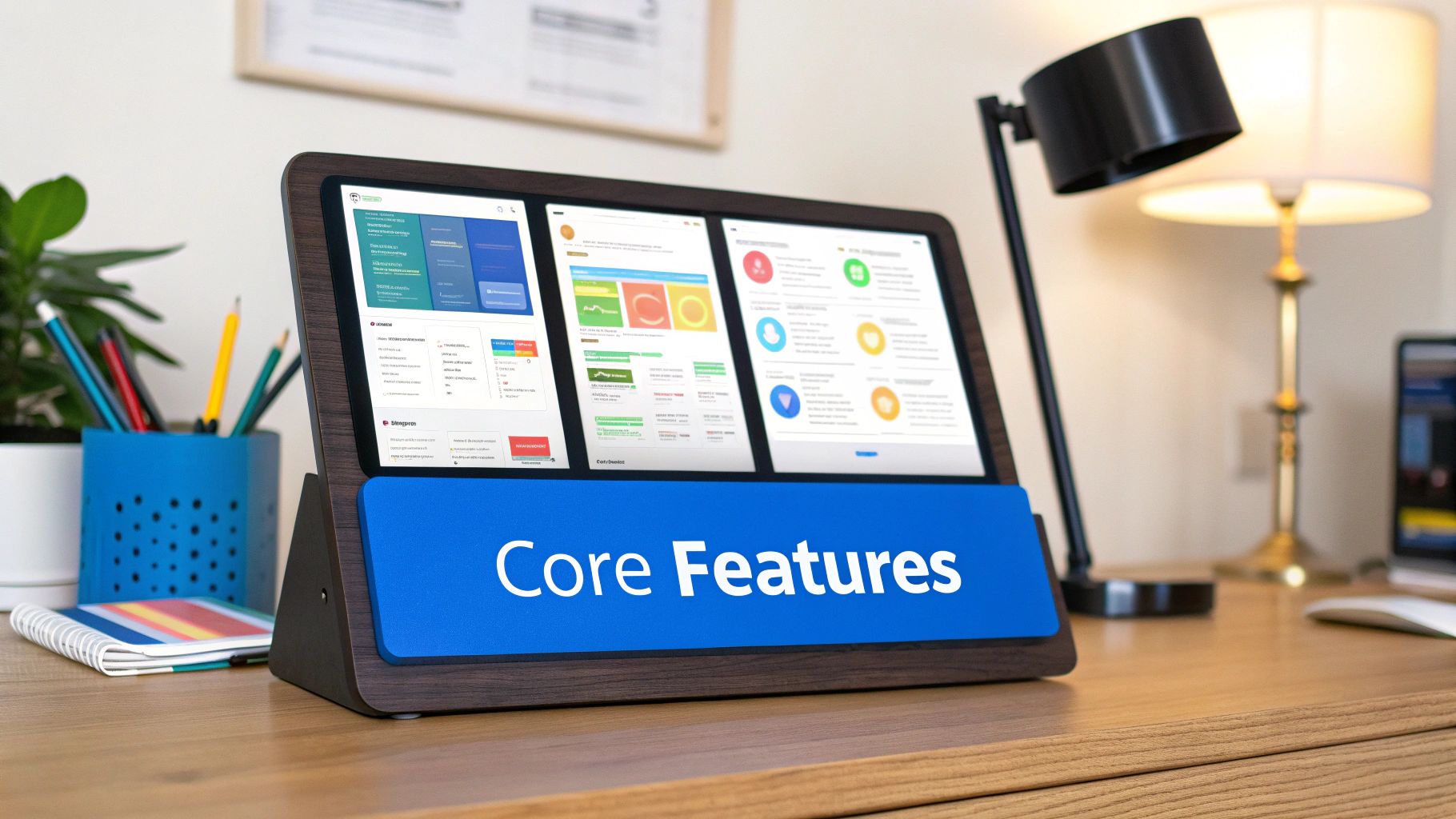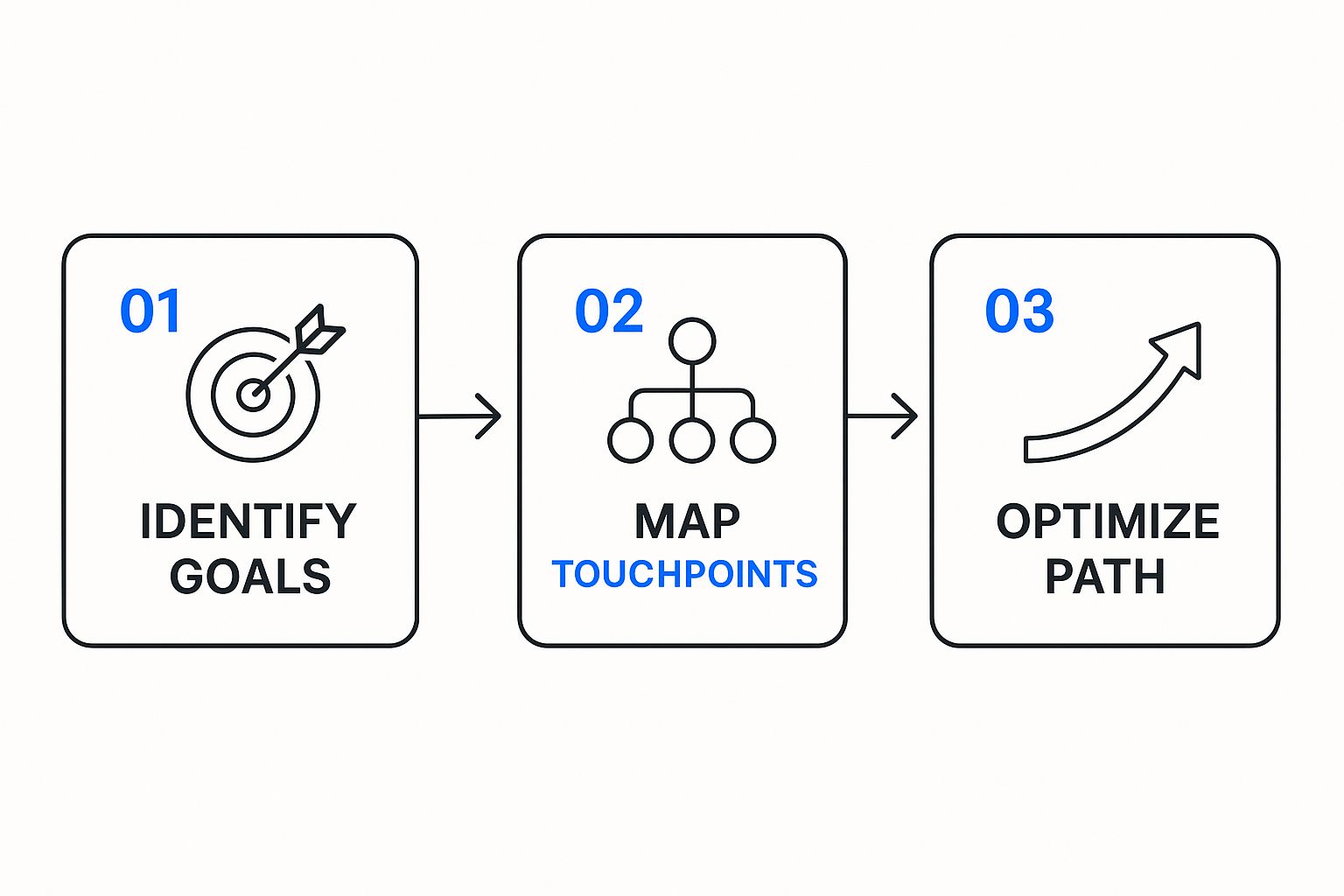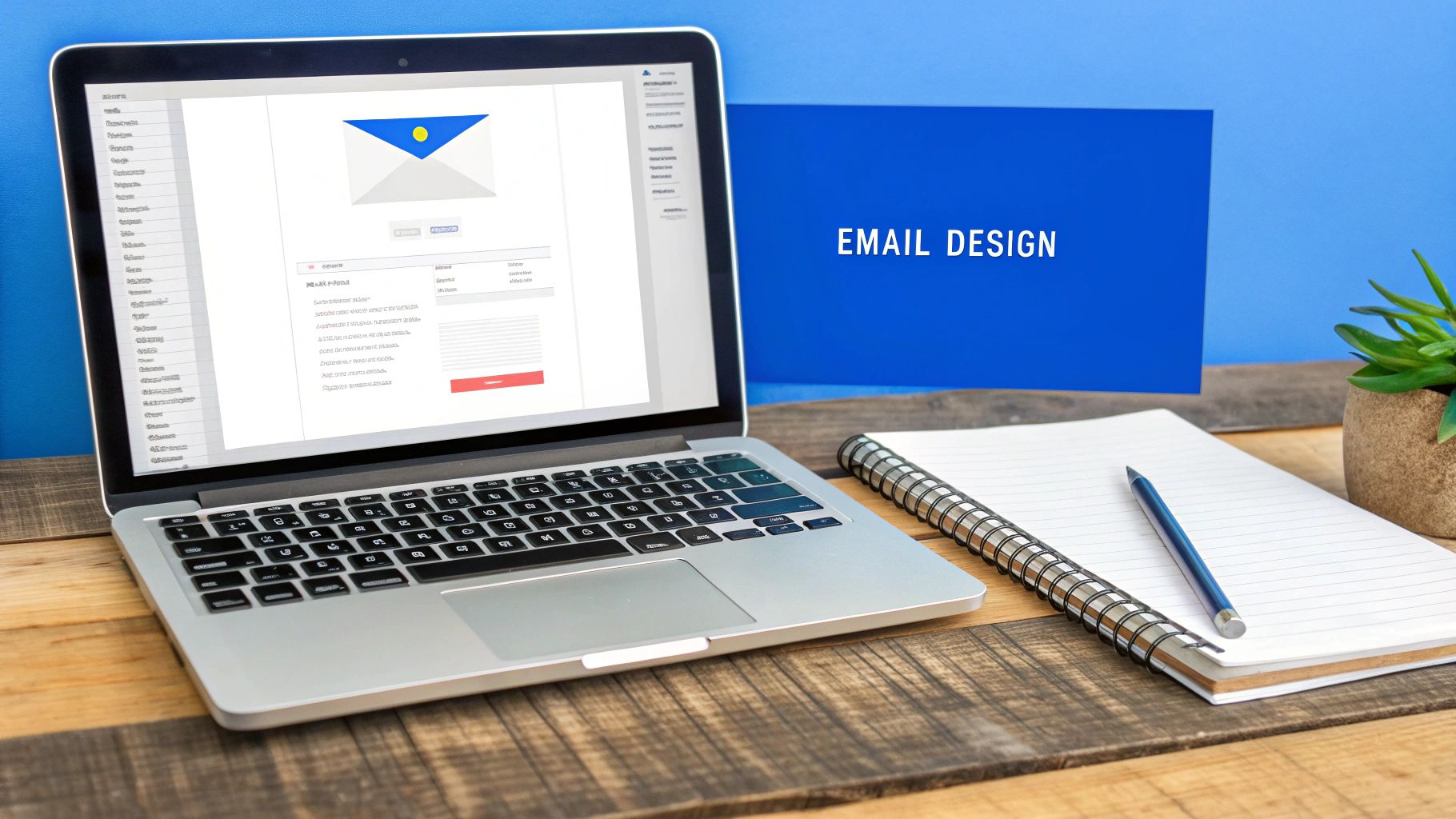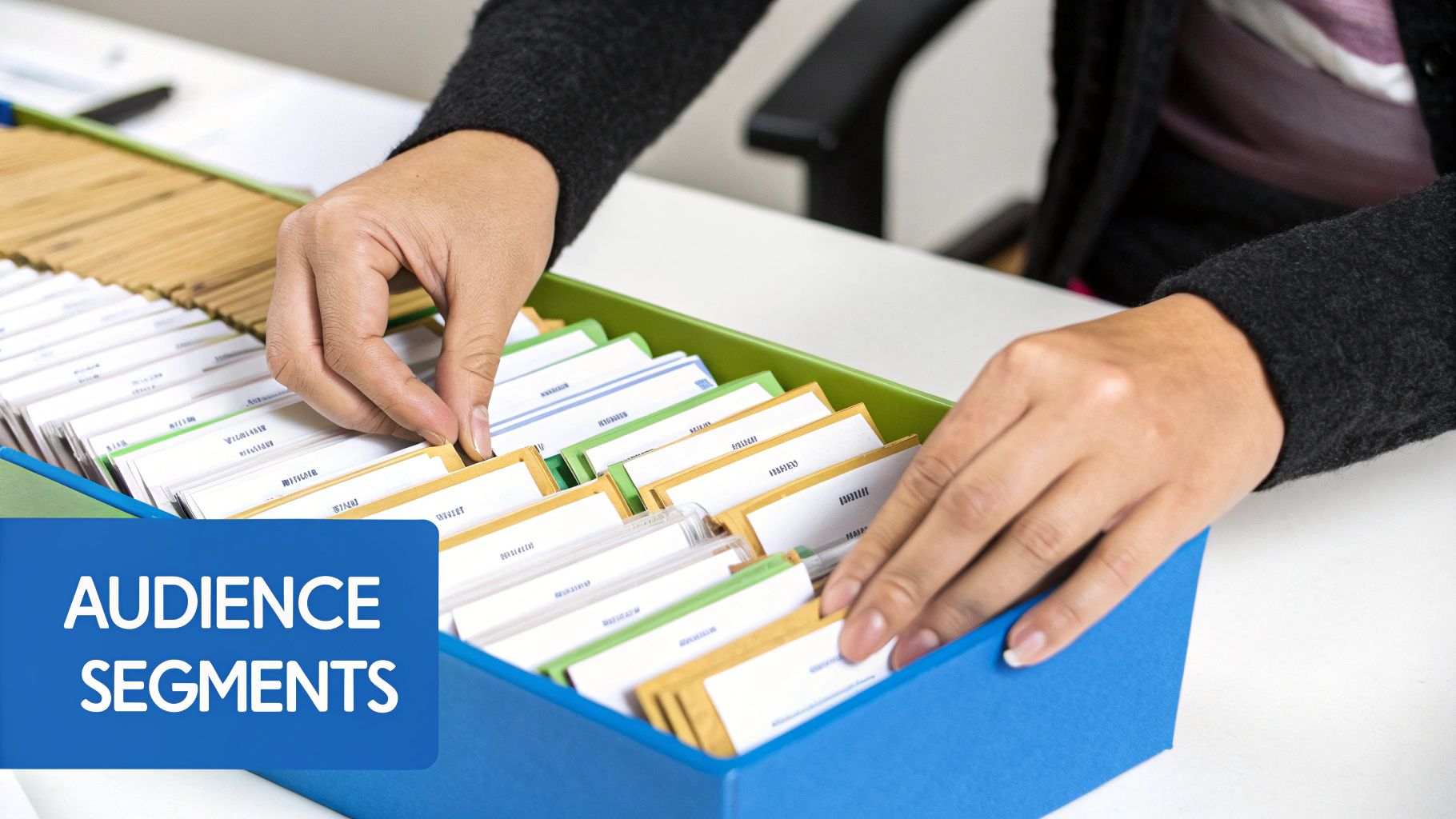A journey builder is a strategic marketing tool that helps you design, visualize, and automate personalized customer paths across multiple channels. Instead of blasting out one-size-fits-all campaigns, it helps you create dynamic, responsive experiences that guide customers from initial awareness to long-term loyalty based on their specific actions.
Imagine you're a tour guide for your customers. A basic email list is like handing everyone the same generic brochure and hoping for the best. A journey builder, on the other hand, is like being a personal guide who knows exactly when to point out a landmark, suggest a coffee shop, or offer a shortcut based on each person's interests and behavior.
This tool moves beyond simple, linear automation. It's more like a visual canvas where you can map out every potential interaction a customer might have with your brand. The real goal is to orchestrate a seamless experience that feels personal and relevant at every single step.
Traditional automation might send three welcome emails over three days, no matter what the user does. A journey builder operates on a far more intelligent level. It uses "if/then" logic and decision splits to create branching paths that adapt in real time.
For example, when a new subscriber enters your journey:
This ability to react to real-time behavior is what makes a journey builder so powerful. It ensures your marketing messages aren't just sent, but are delivered at the most opportune moment.
The real power of a modern journey builder is its ability to orchestrate this experience across various platforms simultaneously. The introduction of tools like Salesforce's Journey Builder marked a significant shift toward data-driven, multi-channel marketing automation. Now, companies can deliver campaigns via email, SMS, and social media all from a single, cohesive journey, reaching customers on their preferred platforms. You can explore more on how this technology reshapes marketing strategy and fits into platforms like the Salesforce Marketing Cloud.
A journey builder is not just an automation tool; it’s a strategic framework. It forces you to think deeply about your customer's experience and design interactions that build relationships, not just drive clicks.
Before we go further, it helps to summarize the key jobs a journey builder is designed to do. These core functions are what separate a true journey builder from a simple email autoresponder.
FunctionDescriptionBusiness ImpactVisual MappingProvides a drag-and-drop canvas to design customer paths with decision splits, wait times, and actions.Simplifies complex campaign logic and makes it easier for teams to collaborate on strategy.Behavioral TriggersInitiates or modifies journeys based on real-time customer actions (e.g., clicks, purchases, page views).Ensures messages are timely and contextually relevant, boosting engagement and conversion rates.Multi-Channel OrchestrationManages communications across email, SMS, push notifications, social ads, and other platforms from a single interface.Delivers a consistent and unified brand experience, meeting customers wherever they are.PersonalizationUses customer data to tailor content, offers, and messaging dynamically for each individual in the journey.Increases message relevance, which strengthens customer relationships and improves campaign ROI.Analytics & ReportingTracks performance at each stage of the journey, providing insights into engagement, conversions, and drop-off points.Enables data-driven optimization to improve journey effectiveness and eliminate friction points.
Ultimately, a journey builder matters because it transforms marketing from a series of disconnected campaigns into a single, unified conversation. By visualizing and controlling this conversation, you can eliminate disjointed experiences, increase engagement, and build the kind of brand loyalty that drives sustainable growth.

Trying to tie a single sale back to one specific ad can feel impossible. The modern customer journey isn't a straight line from A to B; it’s a winding road of blog posts read, social media ads seen, emails opened, and retargeting links clicked. This complexity makes marketing attribution—the science of assigning credit to the touchpoints that lead to a conversion—one of the biggest headaches for marketers today.
For years, brands leaned on the deeply flawed "last-click" attribution model. This method gives 100% of the credit for a sale to the very last interaction a customer had before buying. It’s like crediting a championship win solely to the player who scored the final basket, completely ignoring the assists, defensive plays, and teamwork that made it all happen.
This oversimplified view gives you a dangerously skewed picture of what's actually working. It completely undervalues the top-of-funnel content that first introduced your brand and all the mid-funnel nurturing that built trust along the way. This is exactly where a journey builder changes the game.
A journey builder gives you the visual timeline needed to finally move beyond last-click guesswork. It doesn’t just show you the final touchpoint; it lays out every single interaction a customer has with your brand on their path to purchase.
By creating this detailed, chronological map, you can finally see the entire sequence of events unfold. You see the initial Facebook ad that first caught their eye, the follow-up email they opened three days later, and the educational webinar they watched a week before finally pulling the trigger. Each step is another piece of the puzzle falling into place.
A journey builder transforms attribution from a guessing game into a visual science. It lays out every customer touchpoint, allowing you to see which paths lead to revenue and which ones lead to dead ends.
This big-picture view allows you to adopt far more sophisticated attribution models that actually reflect reality. Instead of focusing only on the last click, you can analyze the entire sequence. You can finally start to understand the critical role each channel plays in the journey, from awareness all the way to conversion.
Once you have this level of clarity, the benefits are immediate and powerful. The detailed map provided by a journey builder gives you the hard evidence needed to make smarter financial decisions. You can confidently answer critical questions, like:
This level of detail is essential for proving marketing ROI. You're no longer just reporting on clicks and impressions; you're demonstrating exactly how a specific sequence of marketing activities led directly to revenue. If you're looking to dive deeper into this topic, our guide explains in detail how to measure marketing attribution with greater precision.
By understanding which touchpoints truly influence conversions, you can allocate your budget with confidence. You can double down on the channels delivering real results and pull back from those that only look good on a surface-level report. This strategic allocation is how a journey builder helps you stop wasting money and start investing in what truly drives growth.
To really get what a journey builder does, you have to pop the hood and see how the engine runs. It's less like a simple machine and more like a bustling train station. Customers arrive from all different places, get directed to specific platforms, and travel along tracks designed just for them—all orchestrated by a central control system.
At its core, a journey builder operates on three fundamental pillars: Entry Sources, Activities, and Flow Control. Understanding how these three parts work together is the secret to creating automated campaigns that feel remarkably human and responsive.
Every journey has to begin somewhere. An entry source is the specific event that qualifies a customer to be placed onto an automated path. This isn't a one-size-fits-all starting gate; it's a dynamic system that can pull people in from dozens of different interactions they have with your brand.
Some of the most common entry sources include:
The entry source defines both the who and the why of the journey. A customer who enters because they downloaded a whitepaper needs a completely different experience than someone who just signed up for your loyalty program.
Once a customer is on their path, the journey builder uses activities to interact with them. These are the marketing actions you take at each step. This is where the true multi-channel power of a journey builder shines, as you can mix and match different communication types to build one cohesive experience.

This visual shows the strategic steps behind any good customer journey, making sure every path is goal-oriented, data-informed, and always improving.
Activities can be anything from sending a promotional email to updating a customer’s profile in your CRM. Because the system is fueled by rich data, it can tailor these messages based on what each person actually does, which can drive engagement rates up to 15-25% higher than what you'd see with generic, one-off campaigns. Plus, the visual interface can slash campaign setup times by as much as 50%.
This is the brain of the whole operation. Flow control elements are the decision points that create those personalized, branching paths for your customers. They run on simple "if/then" logic to send people down different routes based entirely on their behavior.
Flow control is typically managed with a few key tools:
By combining these simple elements, you can design something like a welcome series where a user who clicks on "women's shoes" gets a totally different follow-up email than someone who clicked on "men's coats." It’s this fine-tuned control that transforms a generic automation into an experience that feels truly personal. For a closer look at the practical side of implementing these workflows, check out this guide on setting up marketing automation effectively.

It’s one thing to understand the theory behind a journey builder, but it’s another to see it actually make a difference for a business. The real magic happens when you use its logic to solve tangible, high-stakes marketing problems. Whether you're trying to recover lost sales or guide new leads toward becoming loyal customers, a well-designed journey has a direct and measurable impact on your bottom line.
The great thing about a journey builder is its versatility. It doesn't matter if you're selling physical products, SaaS subscriptions, or high-ticket coaching. The core idea of sending personalized, triggered messages stays the same.
Let’s dive into a few powerful, real-world examples where this technology really proves its worth.
This is probably the most famous—and profitable—use case for a journey builder. A shocking 69% of online shopping carts are left behind before the purchase is finished. A smart journey can claw back a huge chunk of that lost revenue, turning a moment of distraction into a second chance to buy.
Here’s how a standard cart abandonment flow usually works:
This multi-step strategy is way more effective than a single, lonely reminder. It methodically chips away at potential obstacles, from simple forgetfulness to price concerns, guiding the user back to complete their purchase. Plus, by tracking which touchpoint finally gets the conversion, you gain priceless insights into what motivates your audience.
In the B2B world, the sales cycle can be incredibly long and often requires a lot of education. A journey builder is the perfect assistant for automating this nurturing process. It builds trust and keeps your brand front and center, from the moment someone downloads a resource to the final sales call.
Let's say someone downloads a detailed whitepaper from your website.
This single action is a clear signal of interest. A journey builder ensures this initial spark of curiosity is nurtured into a real sales opportunity, rather than being forgotten.
The journey kicks off instantly:
This automated flow ensures that by the time a lead actually talks to a salesperson, they're already informed, engaged, and highly qualified. The entire sequence demonstrates the power of tracking interactions across different types of content. The data you gather helps you map the customer path, which is a core idea in multi-touch attribution. For a deeper dive, we have a helpful article that explains how to implement multi-touch attribution so you can give credit to every step of the buyer's journey.
A journey builder is fantastic at choreographing the customer path, but it can only work with the leads it's given. Think of it as a high-performance engine. To truly unlock its power, you need to fill its tank with the highest-octane fuel you can find. In marketing, that fuel is clean, accurate attribution data.
Without clear attribution, you’re essentially feeding this sophisticated engine low-grade, questionable traffic. You might be pouring money into ad campaigns that look good on paper but are actually bringing in unqualified leads who will never convert. This is where dedicated attribution tools come in, turning a good strategy into an unbeatable one.
A journey builder is an expert at managing the what and when of your marketing—what message to send and when to send it. An attribution tool like Cometly, on the other hand, zeroes in on the who and why. It tells you exactly who your best customers are and which ads or channels brought them to your doorstep in the first place.
This powerful combination creates a closed-loop system for constant improvement. The attribution tool identifies your most profitable ad campaigns, letting you double down on what works. In turn, you feed a higher concentration of quality leads directly into your carefully crafted journeys, which dramatically boosts their effectiveness and your overall ROI.
A journey builder designs the perfect racetrack for your customers. An attribution tool ensures you’re only letting the fastest cars onto the track, maximizing your chances of winning.
This synergy allows you to move beyond just managing a customer path; you start actively optimizing the entire marketing funnel from the very first click. You stop wasting budget on channels that don't deliver and start investing exclusively in the sources that generate real revenue.
The true power of this pairing comes from unifying two distinct but complementary datasets. Your journey builder tracks engagement within your ecosystem (like email opens and SMS clicks), while an attribution platform tracks how customers got into your ecosystem. When you bring them together, you get a complete, end-to-end view of performance.
Here’s what that looks like in practice:
By analyzing both, you might discover something crucial. One ad campaign could be driving a high volume of sign-ups, but those leads rarely engage with your journey. Meanwhile, a smaller, more expensive campaign might be sending leads who convert at a rate 3x higher. Without both pieces of the puzzle, you'd never spot this insight.
To help you get the full picture, we've put together a table comparing the primary focus of each tool.
While journey builders and attribution tools can both map customer interactions, they serve fundamentally different primary roles. A journey builder is focused on orchestrating the path, while an attribution tool is focused on understanding the source and its value. This table breaks down the key differences.
As you can see, these tools aren't in competition—they're complementary. A journey builder executes the plan, but an attribution tool like Cometly provides the intelligence to ensure it's the right plan, fueled by the right traffic.
This integrated approach is fundamental to building a robust marketing system. You can learn more by reading this complete guide to multi-touch attribution to see how every interaction gets the credit it deserves.
Ultimately, you’re no longer just building journeys; you’re building profitable journeys fueled by data-proven traffic sources. It’s the key to turning your marketing efforts from an expense into a predictable, scalable growth engine that consistently delivers results.

The customer journey builder isn’t standing still. It’s getting smarter, faster, and more predictive every day. We’re moving beyond the world of reactive, rule-based paths and into an era where AI and machine learning proactively shape customer experiences. It's a shift that promises a level of personalization that once felt like science fiction.
Imagine a journey that doesn’t just respond to a customer's last click, but actually anticipates their next move before they even realize what they need. That’s the core promise of an AI-driven journey builder. These systems analyze massive datasets to spot subtle patterns, predicting which customers are about to churn, which are ready for an upsell, and what message will hit home at the perfect moment.
This evolution is all about moving from simple automation to true orchestration. Instead of a marketer manually setting up every decision split and "if/then" scenario, machine learning algorithms will start auto-optimizing paths in real time. They’ll test thousands of variations on their own, learning which sequence of emails, SMS messages, and ads delivers the best results for different customer segments.
The pinnacle of this evolution involves leveraging the power of GenAI in customer service with Salesforce and Zendesk and other integrated platforms to create hyper-personalized experiences at a scale that would be impossible to manage manually.
The future of the journey builder isn't about building more complex static maps; it's about creating a living, self-learning system that adapts to each customer individually and anticipates their next move.
This intelligent future is powered by a growing universe of data. The next generation of journey builders will pull information from a wider-than-ever array of sources to build a truly unified customer profile. Think about data coming from:
By weaving all these disparate data points together, marketers can finally deliver on the promise of a seamless omnichannel experience. A question asked to a home assistant could trigger a personalized offer in a mobile app, which is then reinforced by an email. Making sense of this complex web of interactions is the entire focus of advanced customer journey analytics, a discipline that becomes even more critical in this data-rich world.
The results of this sophisticated approach are already clear. For instance, Salesforce has reported that companies using its Journey Builder have seen up to a 30% increase in customer retention rates and an uplift of over 20% in marketing ROI. These wins come directly from delivering tailored, timely interactions that feel like they were made just for one person. It's clear that technology is making customer journeys more predictive and seamless than ever before.
Let's be honest, the world of marketing automation can get confusing, and new terms seem to pop up every day. As you start to think about mapping out customer experiences, you're bound to have questions.
We get it. That's why we’ve put together some quick, no-fluff answers to the most common questions we hear about journey builders.
Think of basic email automation as a one-way street. A user signs up, and they get a pre-set, linear sequence of emails—welcome email one, then two, then three. It’s static. It doesn’t really care what the user does; it just follows the script.
A journey builder is more like a dynamic, multi-lane highway with exits and on-ramps. It creates paths that adapt to what a customer actually does, in real-time and across multiple channels. It uses "decision splits" to change the experience based on opens, clicks, or website visits, sending users down entirely different routes to make sure every message hits the mark.
The core difference is responsiveness. Basic automation follows a script; a journey builder has a real-time conversation across email, SMS, and even social ads.
Not anymore. While massive platforms like Salesforce Journey Builder definitely own the high-end enterprise space, the strategy and the tech are now available to just about everyone. Many marketing automation tools built for small and medium-sized businesses now have incredibly powerful visual journey-building features.
The key is to find a tool that fits your team's needs and budget. The core idea—guiding customers through a personalized path—is valuable for any company trying to boost engagement and sales, no matter its size.
This really depends on how complex your journey is. A simple, three-step welcome series? You could probably get that designed, written, and launched in a few hours. It’s a pretty straightforward path with minimal logic.
But if you’re building something more intricate, like a multi-path cart abandonment flow that pulls data from your e-commerce store and uses several decision splits, that might take a few days of solid planning and setup. The good news is that modern drag-and-drop interfaces have made the technical part much easier, so you can spend more time thinking about strategy instead of code.
Absolutely, and you definitely should. Most journey builder platforms come with analytics dashboards designed for this exact purpose. These tools are built to track key metrics at every single stage of the path you create, including:
By setting a clear, measurable goal for every journey you build, you can calculate its direct financial impact and prove its worth. To do this right, you need to know all the different ways a customer interacts with your brand. You can learn more by exploring the various customer journey touchpoints and how each one contributes to the final sale.
Ready to stop guessing and start knowing which ads are actually fueling your customer journeys? Cometly provides the crystal-clear attribution data you need to optimize your ad spend, feed higher-quality leads into your funnels, and maximize your overall marketing ROI. See how it works at https://www.cometly.com.
Learn how Cometly can help you pinpoint channels driving revenue.
.svg)
Network with the top performance marketers in the industry